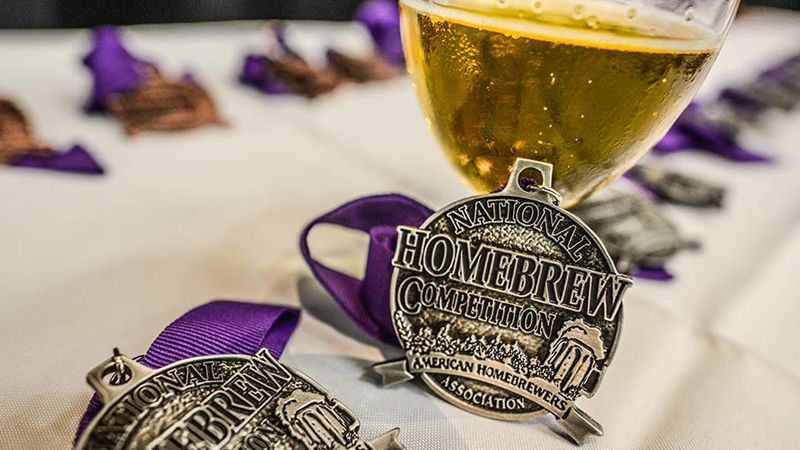Just like so many events in the last year, the 2021 National Homebrew Competition will look different than it has in the past. Luckily, it will look very different from the 2020 competition, which was canceled in March as part of the national response to the Covid-19 pandemic — after homebrewers’ first-round entries had already been mailed in.
This year will be the first time the competition will be judged at a single location, instead of at 10 or more disparate sites across the country. A single-round setup means many entrants will be shipping beer for the first time, instead of dropping it off at a judging location, because in previous years only those who made it to the final round needed to ship entries. This means more logistics to consider like cost and packing materials.
It also means the competition is truly a national head-to-head.“You’re truly going against every entry in a category, rather than having all those entries split out over regional sites,” says John Moorhead, NHC director and competition manager of the American Homebrew Association. “It kind of ups the prestige.”
After having the homebrewer’s equivalent of “the big game” canceled in 2020, homebrewers are more eager than ever to put up their best brews for competition.
What is the National Homebrew Competition?
*There are hundreds of competitions put on by regional clubs and commercial breweries that provide homebrewers with the opportunity to get unbiased feedback on their beers and advice for honing their craft. Many of these are prestigious, and some are even recognized nationwide (the Bluebonnet Brew-Off and the San Diego State Fair come to mind), but the National Homebrew Competition (NHC) is akin to the homebrewing Super Bowl. With almost 10,000 entries coming from roughly 3,500 homebrewers, it is the largest homebrew competition in the world.
“It’s a very different level from what homebrewers compete in inside their home cities,” says Scott Kurtz, who has entered NHC five times and is now head meadmaker at Bluewood Brewing in St. Louis. “What could normally end up on a best of show table at a local or regional competition may not be enough to even make it through to the category best of show at [NHC] Finals.”

What Will Be Different for Entrants?
In a year without a global pandemic, the first round of NHC takes place at 10 regional locations across the U.S. This year, the competition will be held in one mega round taking place near the American Homebrew Association’s headquarters in Denver (at this time, the location is not disclosed). In addition, in order to keep everyone as safe as possible, the number of judges is limited to “40 to 45 judges a day,” says Moorhead, unlike in the past when organizers recruited many more judges so entries could be evaluated as efficiently as possible. (This year, judges will practice social distancing and use face shields, two practices that were successful at GABF last year.)
The highly selective nature of this smaller judging group is good news for competition participants. All judges participating in the National Homebrew Competition will be Beer Judge Certification Program (BJCP) judges who rank at the national level or higher; or professional judges who participated in the Great American Beer Festival (GABF) competition last year.
Having such esteemed judges is a step up for most entrants, who will get score sheets as the only reward for their beers. “The ribbons are nice, but I mostly look forward to getting the score sheets and feedback,” Pia Sen, president of The Brewminaries homebrew club based in Brooklyn, says.
Because fewer people will be judging entries, judging will take a full week. But beers will be well taken care of while they patiently await their judgement day, Moorhead says. “They’re being kept at cellar temperature, if not refrigerated, from the moment the shipping window starts to the judging,” he says.
Though past NHC entrants are accustomed to a two-round system, the 2021 format of one ongoing round is still recognizable to anyone who has entered a homebrew competition in the past. “I know some folks won’t be thrilled about the one round, but given the Covid risk and the logistical issues, makes perfect sense as to why it’s being done that way,” says Kurtz.
All entries from a single category (Specialty IPA or Dark European Lager) will be broken up into flights of eight to 12 beers. These flights will be assessed by pairs of judges. From those flights, three beers will move forward to the next flight. This process will continue until the group moving forward is 12 beers or fewer.
At this point a final table is assigned and a panel of five judges will score that final group of 12 or fewer entries. Every beer making it to this final table will also receive an award — that recognition substitutes for a first-round ribbon from past years, Moorhead says. This can be a boon for brewers entering to improve their skills.
“I think the extra ribbons are a good idea,” says Kurtz. “Sometimes that’s the catalyst homebrewers need to stick with it and keep growing; other times it’s that feeling of accomplishment, the chance to show family and friends that you really know what you’re doing.”
Judges will determine a first-, second-, and third-place winner at each category’s final tables. Those entries will receive gold, silver, and bronze medals. Gold medal winners from each category will move on to a best of show round. The top beer in that round will determine the 2021 Homebrewer of the Year.
How Much Beer to Send?
Because of these extra rounds of judging, the NHC is asking entrants to send six individual bottles per entry, more individual bottles than past competitions. Moorhead says that people who are concerned about sending that many samples can send four or five bottles, but they should be aware of the consequences.
“When we get to that situation where we only have four [bottles] and we need a fifth, but don’t have it, there’s not a whole lot we can do,” he says. “I would hate for an entrant to get that far in the competition and then just not have [a sample to judge] because they didn’t want to send an extra bottle or two. I’d rather have those bottles available and give them a good chance of winning a medal or winning the best of show.”
Sending extra bottles also ensures there won’t be any hiccups in the judging phase because of issues like bottles damaged in shipping. Sen, who enters the competition with her homebrew club, The Brewminaries, says she is “kind of looking forward to this simplified format. It is a bit more expensive up front, but I’m happy to support the AHA [American Homebrew Association] and think the additional precautions they are taking to make this happen are worth the cost.”

Packing and Shipping Tips
Speaking of keeping your bottles safe in the mail, Moorhead has advice on that, too. When packing up precious entries, it can be tempting to wrap them in many layers of protective packaging and secure them with tape and other packing materials. He has a definitive request on that: “Please don’t do it.”
Items like packing peanuts, bubble wrap, and plastic bags can’t be recycled, and he urges entrants to use them sparingly if at all. As an alternative, he recommends using boxes from Spirited Shipper because they can be recycled, cutting down on the competition’s overall cost in time sorting entries, as well as its carbon footprint. “Think about the packaging you’re using and multiply that by two thousand or so,” Moorhead says.
Shipping companies have notoriously flimsy rules, which Moorhead has advice for navigating: “Pay for the shipping online, then print the label, and package the beer securely yourself,” he says. Entrants can then schedule a pickup time instead of dropping the package off at their local shipping service branch, like UPS or FedEx. This is a free service, so it saves time and avoids any scrutiny that a branch may have when accepting a package.
“I recommend two- or three-days shipping, even though ground is cheaper,” Moorhead says. A little known fact (because really, why would you need to know this unless you were responsible for thousands of beer entries being shipped nationwide?) is that ground shipping is often outsourced by private carriers like FedEx and UPS to smaller companies that may have their own rules and policies. In the past, this has resulted in packages being held back by these smaller companies because of leakage or lack of adherence to a different set of shipping policies.
Perhaps the best way to save time, hassle, and money is getting together with a homebrew club or other brewers in the area to ship your entries freight. “If you can get to the minimum weight, it’s about 30 cents a pound to ship,” Moorhead says.
(Most carriers have a minimum weight of 150 pounds. A 12-ounce bottle of beer weighs roughly 1.25 pounds, so at 6 bottles per entry, you only need 20 total entries to reach the minimum; not too hard to cobble together with a decent-sized homebrew club.)
For the Love of Brewing
This is an intense competition, with a large number of entries — only about 1 percent of entries will win a medal at NHC. Taking that into account, along with the expense of participation, is important, but brewers seem to agree on motivations other than the awards podium.
Some brewers enter for the technical challenge, which for Kurtz includes getting “mash and fermentation temps right, [using] a certain set of ingredients for the intended style, [having] carbonation levels dialed in … [the] list goes on and on.”
Others do it for the feedback, which, as previously mentioned, will take a step up with more esteemed judges this year.
Sen, who has been brewing for seven years, says “it’s really important to keep it in perspective. I once entered a spiced beer that I absolutely loved, and the judges decidedly did not. The beer was definitely a weird one and not for everyone, and the scoresheets gave me some good food for thought on tweaking the ingredients.” But, she says, “I still love it!”
